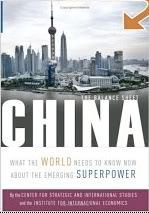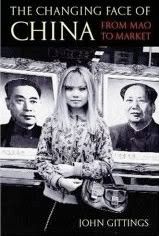China's Internal Crisis
Stephen Glain
It is a measure of how all-consuming the Bush Administration's quest to transform the Middle East is that this week's visit by Chinese President Hu Jintao will be denied the spotlight it deserves. While Afghanistan smolders, Iraq burns and Iran shuffles into America's cross-hairs, only a handful of constituencies understand or seem to care that Washington's relationship with Beijing is vulnerable to manipulation by the Pentagon.
The Defense Department has met its long-term enemy, and it is China [see Michael T. Klare, "Revving Up the China Threat"]. The Pentagon's latest budget, together with its Quadrennial Defense Report released in February, heralded the Yellow Peril in support of every manner of cold war-era weaponry, from the Virginia class nuclear submarine to the F-22 Raptor fighter jet. Even Defense Secretary Donald Rumsfeld has tried to limit, or even kill, some of these programs. And while thoughtful parties in Beijing may understand that these outdated systems are nothing more than job mills for key legislative districts, it gives hawks in China leverage to push for their own arms buildup.
The Pentagon's vision of China as a dangerous hegemon diminishes the farther one gets from the Beltway Biosphere. In the Middle East and Africa, the Chinese model for economic development--autocracy that mutes political freedoms in exchange for commercial expression--is embraced far more eagerly than Bush's prodemocracy crusade. In Asia, US allies like the Philippines, South Korea and even Australia are aligning themselves closer to Beijing, or at least hedging their bets. Only Japan has remained in lockstep with Washington--boosting its own military budget, adjusting its laws to allow the US forces it hosts greater autonomy and whipping its population generally into a Sinophobic frenzy that sits just fine with hawks in Washington.
But nowhere does the image of China as the Next Big Threat jar with reality more than in China itself, where economic, social and environmental upheaval has turned the country into a caldron. For now at least, the Chinese regime is a greater threat to its own population, unmoored and angry, than it is to the United States or even its neighbors. Popular unrest is now a common feature of China's political landscape, with more than 74,000 reported cases of unrest in 2005, according to an official count. The same economy that has grown by nearly 10 percent a year for the past twenty-five years has also become a perilous source of discontent.
Take the December riots in the southern Chinese city of Dongshan, when riot police fired on villagers as they protested the seizure of their land to make room for a power plant. Some twenty people were killed, according to witnesses, in the first such lethal show of force since the Tiananmen Square massacre in 1989. The clash in Dongshan was only the latest in a running nationwide feud between local authorities and angry Chinese uprooted or marginalized by the country's unbridled economic expansion. Just last week, violent protest erupted in Bo Mei, a village in southern Guangdong province, when authorities tried to destroy unauthorized water dikes. Some two dozen people were wounded in clashes with riot police.
While the Bush Administration inflames the Muslim world, Beijing confronts its own fires ignited by an increasingly cutthroat and corrupt economy. National income has risen dramatically since China adopted free-market reforms in the late 1970s, but so has income disparity. The country is straining under an urbanization drive that in the past two decades has eliminated some 135 million rural jobs and has turned much of China's cities into ghettos for uneducated migrant workers. A number of credit cooperatives have failed, taking the meager savings of itinerant laborers down with them. Privatization of state-owned companies and appropriation of farmland for mushrooming urban communities have been exploited into asset grabs by colluding apparatchiks.
The northeastern Rust Belt province of Liaoning, the foundry of Chinese Communism, is now its epicenter of unrest. According to official police figures, one in twelve major demonstrations in China last year occurred in Liaoning, the consequence of a privatization program that left in its wake an angry legion of pink-slipped engineers, line managers and office clerks.
"Liaoning has by far the highest number of protests in China," says Murray Scot Tanner, a senior China analyst at the Rand Corporation. "And we've actually seen an increase over the last couple of years."
Pretty much everyone of working age in Shenyang, Liaoning's capital, is a cashiered government employee, and many have been denied their pensions. They earn the equivalent of about $2,000 a year, well above the national average of $1,300 but absent the health coverage and other benefits they enjoyed working for the state.
Li Zi Zhong lost his job at the Shenyang City Metal Works after it was privatized in 1998. "It used to be you had guaranteed employment, but no longer," says the 54-year-old Li, who gets by with the help of his daughter, who earns about 700 yuan ($87.50) a month selling art and calligraphy from a tiny stall in Shenyang. "The lower class is suffering due to these free-market changes."
The transfer of Liaoning's state-owned companies and utilities to private parties produced some of China's worst graft on record, with huge factories sold to political cronies for a few yuan. Among the companies liquidated in the past five years was the Shenyang Molding Company, where Cheng Youzhi worked as an engineer for thirty-two years. In 2001 the company was declared bankrupt, relieved of its superfluous workforce and sold to its old director for 1 quai, or about 8 cents.
"The new owners are now rich," says Cheng, who would speak only under a pseudonym for fear of retaliation from municipal authorities. "All the employees were sent home, and then they sold the company, bit by bit. There were demonstrations, but the government would not relent."
Cheng is lucky, however. His pension, though meager, is better than the token buyouts offered to many of his former co-workers. Liu Lianyu lost her job at the Dong City Construction Corporation in 2000 and was given a lump-sum payment of several thousand yuan. She and her husband now sell chickens in one of Shenyang's produce markets, and together they earn about 1,000 yuan a month. That's slightly above the national average, she says, though barely enough for two people to live on in a country where inflation has soared even as government services and benefits have deteriorated--or are denied altogether.
"The pressure and stress is felt everywhere," says Liu.
Around the corner from the market is a curbside scrum of itinerant craftsmen who advertise their services with signs dangling from the frames of their Flying Pigeon bicycles--carpenters, plumbers, housemaids, all for hire by the hour or the day. They are part of the wave of migrant workers who have evacuated China's impoverished villages to find work in its booming cities.
Jiang Xiuyan is a 35-year-old interior decorator from the town of Chaoyang in Western Liaoning. She has been working this curb for several years now, and on a good month she and her husband can make as much as 2,000 yuan.
"Business is not bad," she says. "We can earn an income well above the average, so long as the economy continues to grow."
But what if the economy slows down? Liu looks quizzically.
"I haven't thought about it."***
Stephen Glain, a correspondent for Newsweek International, is the author of Mullahs, Merchants, and Militants: The Economic Collapse of the Arab World (Thomas Dunne/St. Martin's). From 1991 to 2001 he covered Asia and the Middle East for the Wall Street Journal.
Link




0 Comments:
Post a Comment
Subscribe to Post Comments [Atom]
<< Home